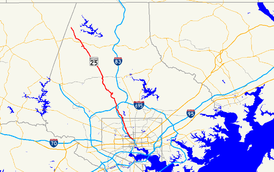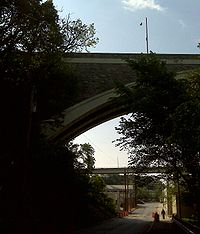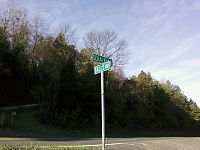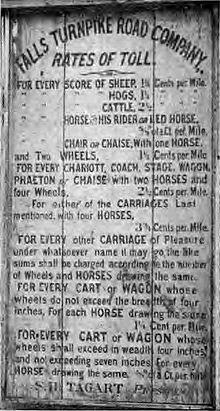- Maryland Route 25
-
Maryland Route 25 Falls Road 
Route information Maintained by Baltimore DOT and MDSHA Length: 26.89 mi[2][3] (43.28 km) Existed: by 1929[1] – present Major junctions South end:  MD 2 in Baltimore
MD 2 in Baltimore
 I-83 / I-695 near Brooklandville
I-83 / I-695 near Brooklandville MD 128 in Butler
MD 128 in ButlerNorth end: Beckleysville Road near Beckleysville Highway system Maryland highway system
Interstate • US • State • Minor • Former • Turnpikes←  MD 24
MD 24MD 26  →
→Maryland Route 25 (MD 25), locally known for nearly its entire length as Falls Road, is a state highway in the U.S. state of Maryland. It begins north of downtown Baltimore, just north of Penn Station, and continues north through Baltimore County almost to the Pennsylvania state line. The road passes through the communities of Hampden, Medfield, Cross Keys, and Mount Washington in the city, and Brooklandville and Butler in Baltimore County. The entire length of MD 25 that uses Falls Road–and its locally maintained continuation north to Alesia–is a Maryland Scenic Byway, named "Falls Road".[4]
Contents
Route description
 Maryland Route 25, facing southbound, as it passes under the 29th (foreground top) and 28th Street (background) viaducts over the Jones Falls valley.
Maryland Route 25, facing southbound, as it passes under the 29th (foreground top) and 28th Street (background) viaducts over the Jones Falls valley.
MD 25 begins as a one-way pair on Lafayette Avenue (westbound, carrying MD 25 north) and Lanvale Street (eastbound, carrying MD 25 south) north of Penn Station. The route starts at MD 2 northbound (Calvert Street), crossing southbound MD 2 (St. Paul Street) one block west. After crossing Maryland Avenue, the two directions join and the road curves to the northwest, becoming Falls Road.
From its beginning to Hampden, Falls Road runs through the valley of Jones Falls, which is shared with the Jones Falls Expressway (I-83), Central Light Rail Line (former Northern Central Branch of the Pennsylvania Railroad), a small piece of the CSX Baltimore Terminal Subdivision, and the abandoned Maryland and Pennsylvania Railroad right-of-way (now partly used by the Baltimore Streetcar Museum). The only intersections on this portion, other than driveways, are with Chestnut Avenue and Clipper Mill Road (the latter where Falls Road leaves the valley); it passes underneath the bridges that Howard Street, North Avenue, 28th Street, 29th Street, and Wyman Park Drive use to cross the valley.
As it climbs from the valley into Hampden, Falls Road meets the ramps from exit 8 of the Jones Falls Expressway. These ramps only allow access from the JFX north to Falls Road north and Falls Road south to the JFX south; other movements can be made to the north at Cold Spring Lane. As it passes through Hampden, Medfield, and Cross Keys, Falls Road is relatively flat and straight, gradually sloping down to return to Jones Falls near Mount Washington, north of Northern Parkway (ranked in 2001 by State Farm Insurance as the most dangerous intersection in the state, based on the number of accidents that have occurred at the location). After leaving the city, a northwesterly climb and descent through Bare Hills (past the Falls Road Animal Hospital and Robert E. Lee Park, which contains Lake Roland) returns Falls Road to the valley for the final time, passing under the JFX, through Rockland (where it intersects Old Court Road/Ruxton Road, carrying MD 133 to the west), over the Baltimore Beltway (I-695), and past the Cloisters to the north end of the JFX (MD 25A here) at Joppa Road in Brooklandville. Since the JFX was built, it has fed directly into Falls Road to the north; traffic remaining on Falls Road must turn. Here Jones Falls turns west through the Green Spring Valley, but Falls Road continues northward. Just beyond are the east end of MD 130 (Greenspring Valley Road) and the west end of MD 131 (Seminary Avenue).
After Brooklandville, the road continues in a general north-northwesterly direction, up hills and down valleys. It passes a number of settlements, including Shawan, Butler (MD 128 west), Coopersville (former MD 401 east and MD 88 west), and Whitehouse (MD 137). When it reaches Beckleysville Road, between Albantown and Beckleysville, state maintenance (and hence MD 25) ends, while Falls Road (formerly Linesboro Valley Road) continues to Alesia as a paved road and scenic byway. Beyond Alesia to the end at Schalk Road Number 1 near Gunpowder Falls, Falls Road is a dirt road.
Public transportation
Falls Road and the nearby areas are served by bus and light rail services operated by the Maryland Transit Administration. The Light Rail, using the right-of-way formerly used by the Pennsylvania Railroad's Northern Central Branch, is at most about 1/2 mile (1 km) from Falls Road within the city. Most of Falls Road here is directly served by the Route 27 bus, which turns off at Kelly Avenue in Mount Washington near the northern city limits; Route 60 continues north into Baltimore County to Brooklandville.
The Route 27 bus is the successor to the No. 25 Mount Washington Line trolley, which was opened on October 17, 1897 by the Pimlico and Pikesville Railroad from downtown to Pikesville, including tracks on Falls Road south of Kelly Avenue. The line was soon taken off Falls Road south of 36th Street, in order to serve Hampden and other populated parts of the city better, as Route 27 still does. Trolleys were replaced with buses on April 24, 1949. The number 25 is now assigned to the Baltimore Streetcar Museum, running on former Maryland and Pennsylvania Railroad right-of-way just east of Falls Road.[5]
History
On the December 27, 1791, the Maryland General Assembly authorized Elisha Tyson, William & Charles Jessop, John Ellicott, George Leggett, Robert Long, Jacob Hart, and John Stricker to lay out a road, not to exceed 40 feet (12 m) wide, from their flour mill-seats on Jones Falls, then in Baltimore County, southerly to Baltimore Town, thereafter known as the Falls Road. [20] On January 19, 1805, A company known as 'The President, Managers and Company, of the Falls Turnpike Road', more commonly called the 'Falls Turnpike', was incorporated and chartered by the Maryland General Assembly. The company was authorized to build and operate a turnpike road "for the accommodation of the inhabitants on Jones's Falls, and the country adjacent", running from "the ford by Messieurs [William] Patterson and [John] Stricker's mill" northerly to "the cross roads by the limekiln of Richard Caton" (Brooklandville). Construction was to begin within two years and finish within five. (Completion was extended to January 1, 1813 by the General Assembly on December 23, 1808.[6]) The law included a statement that "it would be unjust and improper to extend the said turnpike so as to make the same intersect the York-town turnpike...drawing off from said road any portion of the trade that now passes down the said road into Old-town, in the city of Baltimore", but allowed the Falls Turnpike to extend south to the York-town Turnpike (Greenmount Avenue) "at or near a stone bridge opposite the old mill of Josiah Pennington" (Belvidere Street across Jones Falls, just south of Hoffman Street and east of Barclay Street) with the consent of that company.[7] A law passed January 25, 1806 allowed the company to build this extension without the approval of the York-town Turnpike.[8] On December 28, 1812, the General Assembly "confirmed and established" the completed roadway.[9]
According to Richard Caton, whose limekiln was located near the north end of the turnpike, and who was one of the officers of the company, the turnpike was "excepted to unite the trade of the North with Baltimore...in a direct line to Hanover and Carlisle." This extension was delayed by what Caton thought was a desire to keep the Baltimore and Reister's-town Turnpike's monopoly.[10] A public road extending from Brooklandville north-northwesterly to George Kerlinger's Mill on Gunpowder Falls - near but not on the Pennsylvania state line - was authorized by a state law passed December 24, 1808.[11] The Falls Turnpike began building the road, but lacked funds to complete it, and another law passed January 15, 1817 allowed the company to increase their capitalization and to charge tolls for travel on the extension.[12] On March 12, 1828, the General Assembly ordered the company to, within six months, return this extension to the county for use as a free public road, and the turnpike was thus cut back to Brooklandville.[13]
The turnpike began at the intersection of Cathedral Street and Howard Street (now the diagonal portion of Chase Street, intersecting Cathedral Street about half a block south of Biddle Street). It proceeded north on Cathedral Street, crossing Jones Falls a bit north of North Avenue to the current Falls Road.[14][15][16][17] After North Avenue was built, the turnpike was separated from Cathedral Avenue, ending at North Avenue east of Jones Falls.[18]
The description of allowed rates of toll given in the legislative charter are lengthy, and specify that, for instance, a horse and rider shall be charged 6.25 cents, and a two-horse stagecoach 25 cents, for the entire distance, and a smaller amount in proportion to the distance traveled.[7] Five miles were completed by 1811, allowing the company to erect a toll gate; a second gate had been placed by 1819. Due to the impossibility of determining how far a customer had traveled, the Baltimore County Court allowed the company to charge a full toll for passing over any part of the road.[19] The southern toll gate was located one to two blocks north of North Avenue at the bridge over Jones Falls,[20] and the other was several miles north, near Cross Keys.[citation needed]
The road was sold to the state and tolls were eliminated between 1899 and 1910, and the state acquired the extension to Beckleysville Road from the county.[citation needed] The number 25 was assigned in the late 1920s, when the first Maryland Routes were given numbers.[1]
In 1928, the intersection of Falls Road and Belvedere Avenue (now Northern Parkway was the location of the first modern traffic light[21].
Junction list
County Location Mile
[2][3]Intersection Notes Baltimore City
(5.06 mi)0.00
0.06 MD 2 (Calvert Street; St. Paul Street)
MD 2 (Calvert Street; St. Paul Street)1.79  I-83 south (Jones Falls Expressway)
I-83 south (Jones Falls Expressway)Exit 8 of I-83 3.01 Cold Spring Lane To I-83 at exit 9 4.30 Northern Parkway To I-83 at exit 10 Baltimore
(21.83 mi)5.20  MD 746A north (Old Falls Road)
MD 746A north (Old Falls Road)7.34  MD 133 west (Old Court Road); Ruxton Road
MD 133 west (Old Court Road); Ruxton RoadTo I-83 south at exit 12 8.67  MD 25A south (Jones Falls Expressway) to I-83/I-695
MD 25A south (Jones Falls Expressway) to I-83/I-6958.82  MD 130 west (Greenspring Valley Road)
MD 130 west (Greenspring Valley Road)9.22  MD 131 east (Seminary Avenue)
MD 131 east (Seminary Avenue)11.00 Padonia Road (east) / Broadway Road (west) To I-83 at exit 17 14.86 Shawan Road (east) / Tufton Avenue (west) To I-83 at exit 20 17.66 Western Run Road To I-83 at exit 24, via Belfast Road 17.85  MD 128 west (Butler Road)
MD 128 west (Butler Road)18.54  MD 401 west (Stringtown Road)
MD 401 west (Stringtown Road)19.05  MD 88 west (Blackrock Road)
MD 88 west (Blackrock Road)23.30  MD 137 (Mount Carmel Road)
MD 137 (Mount Carmel Road)To I-83 at exit 27 26.89 Beckleysville Road References
- ^ a b Automobile Blue Book, 1929
- ^ a b Maryland State Highway Administration (2005). "Highway Location Reference: Baltimore City" (PDF). http://apps.roads.maryland.gov/KeepingCurrent/performTrafficStudies/dataAndStats/hwyLocationRef/2005_hlr_all/co24.pdf. Retrieved 2009-12-10.
- ^ a b Maryland State Highway Administration (2008). "Highway Location Reference: Baltimore County" (PDF). http://apps.roads.maryland.gov/KeepingCurrent/performTrafficStudies/dataAndStats/hwyLocationRef/2008_hlr_all/co03.pdf. Retrieved 2010-04-21.
- ^ Maryland State Highway Administration, Maryland Scenic Byways, Maryland Byways guidePDF (7.35 MiB), accessed June 17, 2007
- ^ Kenneth Morse, edited by Charles R. Lloyd, Baltimore's Streetcar Routes, published by the Baltimore Streetcar Museum, 1996, pp. 17-18
- ^ Archives of Maryland Online, Session Laws, 1808, Chapter LXIX: "An act to extend the time for the president, managers and company, of the Falls turnpike road, to complete the said road."
- ^ a b Archives of Maryland Online, Session Laws, 1804, Chapter XCI: "An act to incorporate a company to make a turnpike road to lead from the cross roads near Richard Caton's limekiln, in Baltimore county, nearly in the direction of Jones's Falls, to the city of Baltimore."
- ^ Archives of Maryland Online, Session Laws, 1805, Chapter XLVIII: "A supplement to an act, entitled, An act to incorporate a company to make a turnpike road to lead from the cross roads near Richard Caton's limekiln, in Baltimore county, nearly in the direction of Jones's Falls, to the city of Baltimore."
- ^ Archives of Maryland Online, Session Laws, 1812, Chapter 152: "An act to establish and confirm the Falls Turnpike road from the city of Baltimore to Richard Caton's Lime Kiln."
- ^ Maryland Geological Survey Volume Three, 1899, p. 170
- ^ Archives of Maryland Online, Session Laws, 1808, Chapter XCIV: "An act for opening a certain road in Baltimore county therein mentioned."
- ^ Archives of Maryland Online, Session Laws, 1816, Chapter 115: "A Further Supplement to an act, entitled, An act to Incorporate a Company to make a Turnpike Road to lead from the Cross Roads near Richard Caton's Limekiln, in Baltimore County, nearly in the direction of Jones's Falls, to the City of Baltimore."
- ^ Archives of Maryland Online, Session Laws, 1827, Chapter 178: "A further supplement to an act, entitled an act, to incorporate a company to make a Turnpike Road to lead from the Cross Roads near Richard Caton's lime kiln, in Baltimore county nearly in the direction of Jones' Falls to the City of Baltimore."
- ^ Warner & Hanna, [1], 1801
- ^ Archives of Maryland Online, Session Laws, 1805, Chapter XXXIV: "An act to straighten the road leading into Howard-street in the city of Baltimore."
- ^ Archives of Maryland Online, Session Laws, 1810, Chapter LXXXIX: "An act to authorise a Lottery or Lotteries in the City of Baltimore for the purposes therein mentioned."
- ^ Map of the city and county of Baltimore, Maryland. From original surveys by J.C. Sidney, C.E., ca. 1857
- ^ Atlas of fifteen miles (24 km) around Baltimore, including Anne Arundel County, Maryland. Compiled, drawn, and published from actual surveys, by G. M. Hopkins, 1878
- ^ Printed by John D. Toy, Baltimore, Laws, Documents and Judicial Decisions, Relating to the Baltimore and Fredericktown, York and Reisterstown, Cumberland and Boonsborough Turnpike Companies, 1841, pp. 52-55
- ^ Baltimore County Circuit Court, Land Survey, Subdivision, and Condominium Plats, Land Records EHA 67, p. 247, North Central Railway Company deed to Mayor and City Council of Baltimore, July 2, 1870
- ^ http://visitmaryland.org/PressRoom/Pages/Maryland%27sFabulousFirsts.aspx
20. The Chronicles of Baltimore: Being a Complete History of Baltimore Town and Baltimore City From the Earliest Period to the Present Time, Colonel J. Thomas Scharf, Member of the Maryland Historical Society, etc. etc., Baltimore: Turnbull Brothers , 1874, p. 262. See the original 1791 act on line at the Maryland State Archives [2]
Annapolis Road · Aliceanna Street · Artmuseum Drive · Baltimore Street · Bellona Avenue · Biddle Street · Boston Street · Broadway · Broening Highway · Calvert Street · Cathedral Street · Caton Avenue · Centre Street · Charles Street · Chase Street · Coldspring Lane-Moravia Road · Druid Hill Avenue · Eager Street · Eastern Avenue · Eutaw Street · Falls Road · Fayette Street · Fleet Street · Franklin Street · Gay Street · Greene Street · Greenmount Avenue · Greene Street · Greenspring Avenue · Guilford Avenue · Gwynns Falls Parkway · Greenmount Avenue · Hanover Street · Harford Road · Hilton Street/Hilton Parkway · Howard Street · Key Highway · Liberty Heights Avenue · Loch Raven Boulevard · Lexington Street · Lombard Street · Madison Street · Maryland Avenue · McCulloh Street · Monument Street · Mt. Royal Avenue · Mulberry Street · North Avenue · Northern Parkway · Paca Street · Park Heights Avenue · Paca Street · Park Avenue · Patapsco Avenue · Pennsylvania Avenue · Pratt Street · Preston Street · Reisterstown Road · Roland Avenue · Russell Street · St. Paul Street · Saratoga Street · The Alameda · University Parkway · Wabash Avenue · York Road
Categories:- State highways in Maryland
- Roads in Baltimore County, Maryland
- Roads in Baltimore, Maryland
Wikimedia Foundation. 2010.



